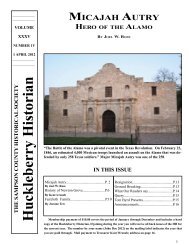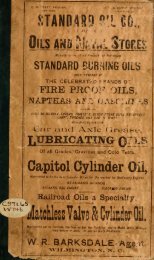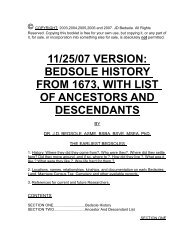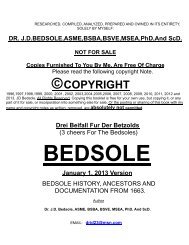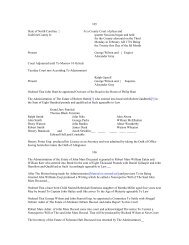Bedsole History from 1673 With Documentation - NCGenWeb
Bedsole History from 1673 With Documentation - NCGenWeb
Bedsole History from 1673 With Documentation - NCGenWeb
You also want an ePaper? Increase the reach of your titles
YUMPU automatically turns print PDFs into web optimized ePapers that Google loves.
Before long however, those who could afford one, had put a large iron bell up on a 30 foot pole at the edge of<br />
their yards which were rung by pulling a rope. About noon every day, the ringing of these bells meant come<br />
and eat, to the field workers. <strong>With</strong> houses so far apart, it was clear whose bell was ringing. If the bell rang at<br />
any other time, especially at night, it meant an emergency had occurred at that particular house, and anyone<br />
hearing it ran to help. Five peals of the bell meant come and eat. Ten meant emergency here, need help.<br />
Twenty, meant a life or death situation had developed at that house and when an emergency occurred some<br />
rode their mules at a dead run, whether in daytime, or the dead of night. But when the bell rang at night, it<br />
filled everyone with dread, for it was a sure sign of very serious trouble at that house. The house was on fire,<br />
someone was dying, they were being attacked by Indians, or other disasters were occurring. The settlers<br />
were collectively hard working people who supported and cared for one another. Each depended on the<br />
others for help if anything happened because the situation could easily reverse tomorrow and usually did.<br />
Women worked themselves to death for their children. Everyone starved because of the lack of adequate<br />
and nourishing food. Most mothers were too starved themselves to feed the babies much and breast milk or<br />
cows milk were painfully inadequate and usually not available. Cows milk was very scarce. Medical care was<br />
non-existent and even if they could find a doctor, he was either too busy, gone to take care of someone else,<br />
or they had no money to pay him. Besides he usually only had herbs and/or Indian cures for medicine. So<br />
people, especially young ones, mothers and babies most of all, were sick a lot on top of the miserable lives<br />
they lived. During childbirth, women were almost always attended by other women and many died <strong>from</strong><br />
excessive loss of blood and infection, following childbirth. More died <strong>from</strong> being undernourished.<br />
In the absence of adequate medical care, many babies died <strong>from</strong> all types of sicknesses usually brought on<br />
by their own malnourishment, lack of medical care and unsanitary living conditions. Everybody usually went<br />
barefooted. Most but not all women, had one pair of shoe's called "Sunday go to meeting shoe's", because<br />
church services, visiting, marriages, or funerals were about the only times they were ever worn.<br />
Although the early settlers had no schools, when one was finaly built, the children had to walk back and forth<br />
to it every day. Sometimes, that was a long distance and school was usually considered a waste of time.<br />
<strong>With</strong> this country being primarily agricultural then, that attitude prevailed until the 1940’s. Very few children<br />
went higher than the second or third grade because they were needed to work in the fields and little<br />
knowledge was needed for that.This was a case of “strong backs and weak minds”. Consequently, even two<br />
hundred years after the early <strong>Bedsole</strong>s arrived here, many still could not read or write and for the few who<br />
could, they had very little “book learning” and usually forgot what little they knew in a short period of time,<br />
because their primary way of life was farming. So, the vast majority of them never went to school at all.<br />
Those who did had to endure unmerciful hounding and being laughed at by all the others, who spent any free<br />
time ridiculing and pointing at each others bare butts, and falling-apart, ragged, hand me down, faded, handmade<br />
pants, shirts, coats, dresses and blouses, which were made either of cloth, leather, or canvas-like<br />
material, usually held together with wire and pegs or nails. Girls, although barefooted like all the rest, usually<br />
wore dresses made of the lightest cloth available at the time. Unfortunately, this was usually also canvas-like,<br />
leather, or hand made cloth. In the winter, everyone suffered mightily <strong>from</strong> the lack of shoes, socks and<br />
winter clothing designed for the purpose. Although the soles of their feet were tough <strong>from</strong> going barefooted,<br />
their feet almost froze in the winter and when thawed-out, all the children cried for hours with the throbbing<br />
pain in their feet.<br />
Back then, winter clothing was very inadequate and the majority of earlier settlers made them <strong>from</strong> deer and<br />
bear hides. Covers for their beds were also animal hides in the winter. Any such hides not properly cured,<br />
were infested with bugs and worms and this was a continuing problem for them. Imagine having to sleep on<br />
a bed made of tree limbs, lying on and under animal hides which were infested with these parasites, which



